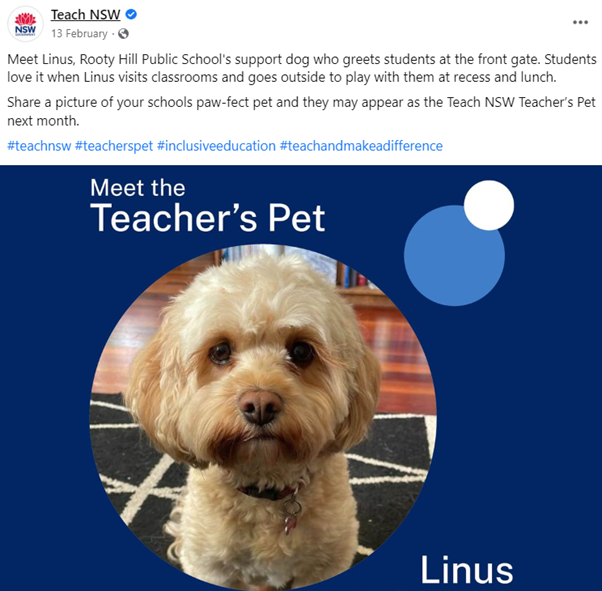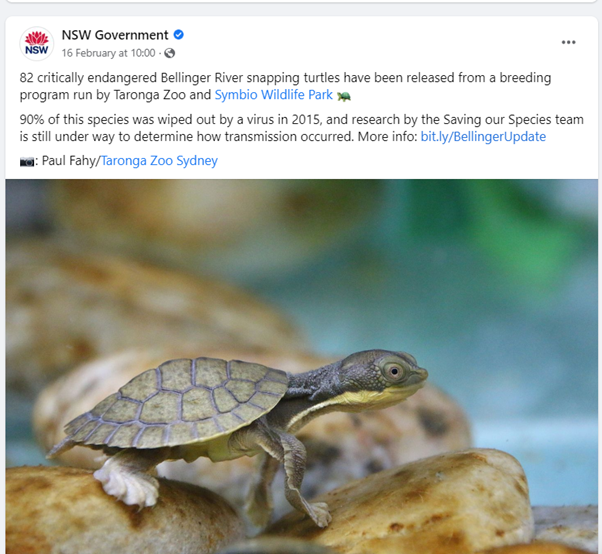Social media copy
Find best practice advice for social media copy.
Copy
People mainly use social media to connect with their friends, family, and community. This requires a different approach to communication than other forms of government messaging. These tips will allow you to effectively reach your audience, tailor your tone and copy to match the specific platform being used.
1. Opening Line
- Keep the opening line short and attention-grabbing.
- Use questions, statistics, or humour (where appropriate) to engage your audience.
- Relate the opening line to the main message of the post.

2. Length
There are different character limits for copy on different social media platforms, as well as preferred lengths (see more in the section on social media platforms).
Keep the copy concise and to the point, while still providing value to your audience.
Consider the visual appeal of the copy. Break up longer paragraphs into shorter sentences and use bullet points or numbered lists to make the copy more scannable.
Vary the length of the copy on each post to keep the audience interested.

3. Language
Consider the demographics of the audience when choosing the tone and style of copy. As general best practice:
- Use plain language, contractions (for example, that’s, you’re, can’t) and simple sentences to ensure your message is easily understood by people with different reading levels and cognitive abilities.
- Use positive language that focuses on benefits and solutions, rather than problems or limitations.
- Use the active voice to make your writing direct, clear, and engaging for your readers. In the active voice, the subject of the sentence performs the action, whereas in the passive voice, the subject receives the action (for example, ‘Anna painted the house’ instead of ‘the house was painted by Anna’).
- Establish an emotional connection to inspire engagement from the audience, using a combination of first-person plural (‘we’ and ‘our’) and second person singular (‘you’).
- Where appropriate, use humour, emojis, popular cultural references, reworking idioms and exploring paradoxes.
- Ensure that the copy is relevant and alludes to the creative and enhances its impact
- Avoid using jargon or slang that may be unfamiliar to the audience.
- Avoid using abbreviations or acronyms that may not be familiar to all users. If you must use them, provide a clear explanation of their meaning.
- Follow the content style guide for formatting best practices when writing numbers, dates and times.
- Be considerate of any advertising requirements.

4. Inclusivity and Accessibility
Australia is one of the most culturally diverse countries in the world so it's important to write for people from all backgrounds. You also need to consider literacy levels, gender, and those who use assistive technology. View our inclusivity and accessibility section for more information.
To promote a more inclusive and respectful tone in your copy, consider these tips:
- Use inclusive language that acknowledges, respects and celebrates diversity.
- Avoid language that could be interpreted as insensitive or offensive.
- Avoid stereotypes or making assumptions about individuals or groups.
- Review your copy carefully before posting to ensure it does not offend or alienate any group of people.
- If writing on a sensitive topic, consult with stakeholders and experts to ensure the copy is respectful and appropriate.

5. Calls to action
Only use one call to action that aligns with the primary objective of the post.
- Place the call to action at the end of the post, after the main message.
- Use a strong verb to start the call to action and encourage users to take a specific action.
- Consider using an emoji to enhance visual appeal and encourage users to click on the link, but not to replace any words.
- Use a shortened personalised link and remove "https://www." before the link.

6. Crediting creators
Crediting creators in user-generated content and other materials is a legal requirement and a best practice that promotes respect for creators and their work. When crediting creators, place credits after the call to action and before the hashtags. If there are multiple sources involved, credit as many as possible.

7. Hashtags
- Use 3 to 5 relevant hashtags to increase reach where appropriate.
- Place hashtags after the call to action, link and credits. Avoid placing them throughout your copy to improve readability.
- Use title case (#WriteLikeThis #notlikethis).

8. Emojis
Emojis can add fun and personality to social media posts and should be used when appropriate. They can help to convey emotions, simplify text and even encourage action.
When using emojis:
- Use a variety of skin tones for people emojis or opt for an all-inclusive yellow skin tone.
- Use caution when using emojis when addressing serious, sensitive or formal issues.
- Avoid using emojis in place of words where possible as this impacts accessibility.
- Avoid using multiple emojis in a row as this can cause issues for people using screen readers.
- Seek advice when using emojis to communicate with culturally and linguistically diverse audiences to ensure they deliver the intended meaning.

9. Exceptions
While it's essential to follow these guidelines for creating effective social media copy, there may be instances where it's necessary to make exceptions.
For example, during a bushfire emergency, a combat agency may need to create posts with multiple links and lots of text to provide critical information without requiring clicks to their website. In such cases, it's vital to prioritise providing valuable information to your audience over adhering to the general social media copy guidelines.

Social Platforms
Best practice copy for different social media platforms
Individual social media platforms have different rules, audiences, and limitations. When you tailor your copy to the specific platform, you’ll maximise engagement and message cut through.
Facebook is a platform where people come to connect with friends and family, as well as discover new content. To create effective copy on Facebook:
- Use a conversational tone that is friendly, positive and informative.
- Use shorter-form copy (up to 200 characters) to capture your audience's attention quickly, while still providing value.
- Use emojis sparingly as a visual enhancement, not as a replacement for text.
Instagram is a visual platform where images and videos are the focus. To create effective copy on Instagram:
- Use concise and engaging captions that complement the visuals.
- Use shorter-form copy (up to 125 characters) to convey your message quickly.
- Use 3 to 5 relevant hashtags to increase discoverability and reach.
- Avoid including links in your copy as users can’t click on them.
LinkedIn is a professional platform where people come to network and learn. To create effective copy on LinkedIn:
- Use a professional and informative tone that reflects the nature of the platform as a professional networking site. focus on industry insights, thought leadership, and professional development in the copy.
- Use longer-form copy (up to 1300 characters) to provide more in-depth information and value to your audience.
- Use 3 to 5 relevant hashtags to increase discoverability and reach.
Snapchat
Snapchat is a platform where users share temporary images and videos. Copy is included directly on the creative itself, therefore it’s essential to follow creative best practice for social media. To create effective copy on Snapchat:
- Use a creative and playful tone to align with the platform’s fun and casual nature.
- Keep your copy short and sweet as Snapchat has a caption limit. Aim for 80 characters or less.
- Include a call to action to encourage interaction.
- Incorporate relevant emojis to add a visual element to your message.
X (formally Twitter)
X is a platform where brevity is key, with a character limit of 280 characters. To create effective copy on X:
- Keep it short, to-the-point, and engaging.
- Use 3 to 5 relevant and trending hashtags to increase reach and visibility.
WeChat is a popular messaging app that is popular with Chinese diaspora in NSW. It also offers social media features. To create effective copy on WeChat:
- Be concise and to the point as the platform has character limits for both headlines and body copy.
- If appropriate, ensure copy has been translated into the correct language. Engage a specialist translator and don’t rely on Google Translate.
- Keep copy informative, educational or entertaining.
- Incorporate keywords and phrases that are relevant to your content to optimise searchability.
YouTube
YouTube is a video-watching and sharing platform. To create effective copy on YouTube:
- Include a clear and concise video title that accurately reflects the content of the video.
- Provide a detailed video description that includes relevant keywords, a summary of the video's content, a call to action and a link.
- To increase the chances of your content being found and seen by more people, include 3 to 5 relevant and popular tags that are currently trending.
Memes and GIFs
Memes and GIFs can be a great way to connect with an audience and deliver a message in a simple format, especially to younger audiences. When used appropriately, the use of these tools can inject some personality and build brand community.
When using memes and GIFs it’s important to remember:
- Sometimes low-res is okay. For example, some memes or GIFs use images of lower quality for humour.
- Memes and GIFs should only be used when it is appropriate. It is not recommended they are used for serious topics, such as mental health, crisis/emergencies or when talking to or about vulnerable audiences.
- Before using memes and GIFs please consider the copyright implications.
Consider A/B testing different content types to determine what resonates best with your audience.
Shortening Links
Links are used in social media posts to connect audiences to additional information and resources.
Shortening the length of links can benefit your social media content by:
- allowing copywriters to stay within character limits for social media copy
- improving accessibility
- enhancing organisational branding and providing neat, simple and easy to read communications
- making it easier for customers to share content
- increasing trust, as customers are more likely to click on a customised link rather than one that ends in a random sequence of numbers and letters
- increasing clickthrough rates (CTR) with customised branding.
When creating a short link:
- only shorten links from NSW Government websites
- customise the link, if possible
- check the link works prior to publishing it
- check the link directs to the correct web page
- use trustworthy third-party platforms to shorten the link.
There are third-party services that offer free and paid subscriptions where a custom link can be created. These companies will also track and analyse click through data, and provide additional data such as audience demographics, the location of the click, and the source or channel of traffic.